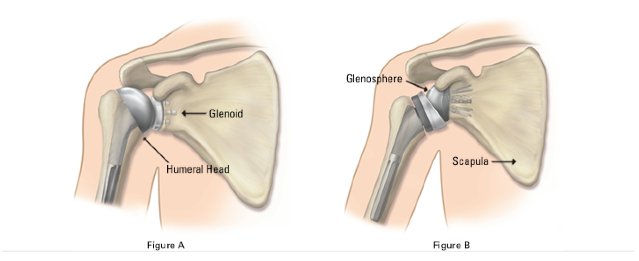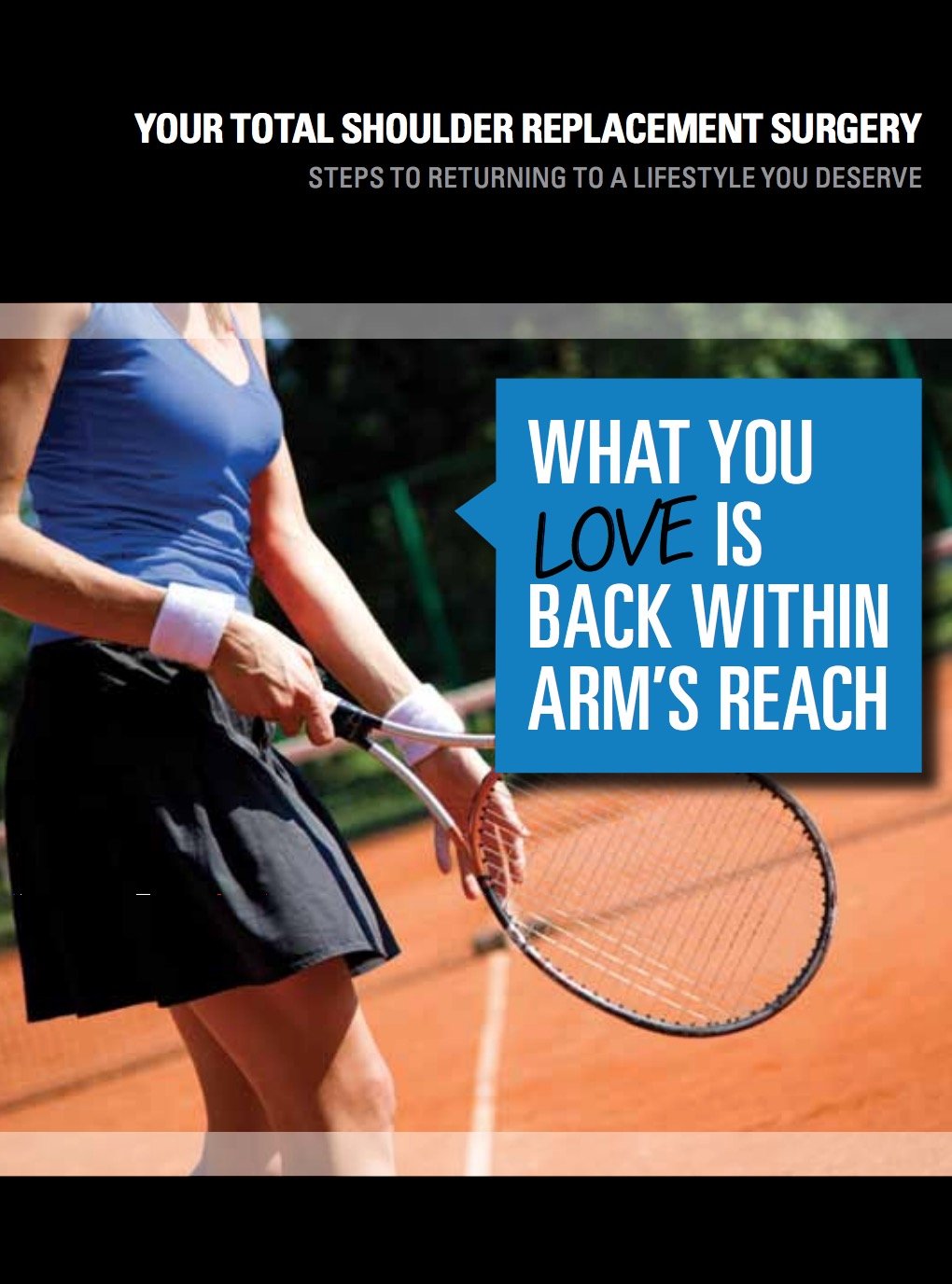Shoulder
Shoulder Anatomy
The shoulder is the most mobile joint in the body, which is why we are able to position our hand so freely for dressing, grooming, hygiene, reaching, and playing sports. The shoulder is comprised of three main bones: the collarbone (clavicle), the shoulder blade (scapula) and the upper arm bone (humerus). The upper end of the humerus is a smooth, rounded head (ball) that fits into the glenoid cavity (socket) of the shoulder blade. Although the shoulder is often referred to as a “ball and socket” joint, in reality it more closely resembles a golf ball sitting on a tee. In a normally functioning shoulder, the four muscle-tendon units that comprise the rotator cuff (supraspinatus, infraspinatus, teres minor and subscapularis) help provide the stability to keep the golf ball centered on the tee.
Common Reasons for Shoulder Replacement
Osteoarthritis
Osteoarthritis (degenerative arthritis), the most common form of arthritis, affects nearly 21 million people in the United States. It is defined by degradation of the cartilage that lines the joint (“wear and tear”). Age, genetics, activity level, occupation, and co-existing medical conditions play a role in the development of osteoarthritis. As the cartilage continues to wear, the joint becomes inflamed and can result in severe pain, limited mobility and strength, and sleep disruption. If non-surgical treatment options such as medication, physical therapy, or lifestyle changes fail to provide relief, Dr. Diaz may recommend total shoulder replacement.
Rotator Cuff Deficiency and Cuff Tear Arthritis
Because the shoulder joint is stabilized by muscles and tendons rather than by bone, the shoulder has great flexibility, allowing us to position our hand in space with great freedom. However, this great degree of motion has a trade off, as the stability of the shoulder is dependent upon the integrity of the four muscle-tendon units (supraspinatus, infraspinatus, teres minor and subscapularis) that comprise the rotator cuff. Most people with a painful rotator cuff tear can be treated arthroscopically. Chronic, massive tears of the rotator cuff are often irreparable and can result in cuff tear arthritis of the shoulder. The degenerated muscles lose their ability to keep the humerus centered on the glenoid, causing your arm bone to move upward and out of the socket, and not allowing you to position your hand in certain ways that can affect reaching overhead, dressing, playing sports, turning a steering wheel, eating, etc. Cuff tear arthritis is often characterized by severe pain and limited mobility of the shoulder, and in most patients is reliably treated with reverse shoulder replacement.
Other causes: Complex Fractures of the Upper Humerus, Post-Traumatic Arthritis, and Rheumatoid Arthritis
Types of Shoulder Replacement
Anatomic Total Shoulder Replacement
Shoulder replacement surgery replaces the damaged part of your shoulder to recreate the natural contours of the bones in a healthy shoulder. During surgery, Dr. Diaz will remove the damaged bone and cartilage and replace with new surfaces to allow for pain free range of motion. In treatment of osteoarthritis with good rotator cuff function, the ball resembles the native ball in shape and is made of metal, and the socket is made of a medical grade plastic (polyethylene). This is called anatomic total shoulder replacement.
Reverse Total Shoulder Replacement
If you are a candidate for surgery and you have pain and dysfunction from a massive, irreparable rotator cuff tear and/or arthritis, Dr. Diaz may recommend a reverse shoulder replacement. In this procedure, the anatomy of the shoulder is reversed by attaching a metal ball (glenosphere) to the glenoid and the plastic socket (humeral liner) to the upper humerus. If you are having a reverse shoulder replacement, the system will help restore pain-free shoulder function by empowering the triangular muscle on the outside of your shoulder called the deltoid to become the main functioning muscle in the absence of a healthy rotator cuff.

The Right Choice For You
Dr. Diaz will consider a number of factors when selecting the shoulder implant that is right for you. Your age, the status of your rotator cuff, your activity level, and your general health are among the most important variables.
If you are scheduled for shoulder replacement surgery with Dr. Diaz, please review Preparing For and Recovering From Shoulder Replacement.
For a list of post-op shoulder home exercises: Click Here.

Hand/Elbow/Wrist
Arthritis – Base of the Thumb
Arthritis at the base of the thumb is a genetic predisposition: like graying and thinning of the hair, it comes with age and it shows up earlier in some families. Patients with arthritis of the base of the thumb report pain and weakness with pinching and grasping.
Carpal Tunnel Syndrome
Carpal tunnel syndrome is essentially a pinched nerve in the wrist. There is a space in the wrist called the carpal tunnel where the median nerve and nine tendons pass from the forearm into the hand. Carpal tunnel syndrome happens when swelling in this tunnel puts pressure on the nerve.
Dupuytren’s Disease
Dupuytren’s disease is an abnormal thickening of the tissue just beneath the skin known as fascia. This thickening occurs in the palm and can extend into the fingers. Firm pits, nodules and cords may develop that can cause the fingers to bend into the palm, in which case it is described as Dupuytren contracture.
Dr. Diaz is honored to be carrying on the tradition of excellence in the treatment of Dupuytren Disease set forth by Dr. Charles Eaton, MD. To learn more about ongoing research efforts related to Dupuytren Disease and connect with others, visit The Dupuytren Research Group.
Wrist Fractures – Distal Radius Fracture
The wrist is made up of eight small bones and the two forearm bones, the radius and ulna. Wrist fractures may occur in any of these bones when enough force is applied to the wrist, such as when falling down onto an outstretched hand.
